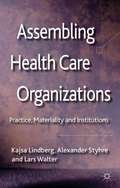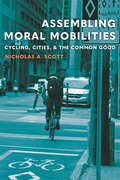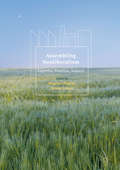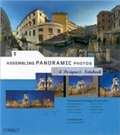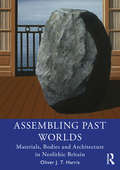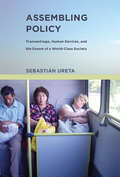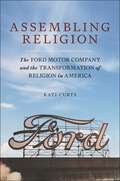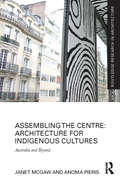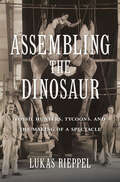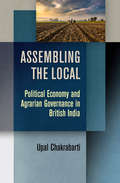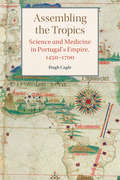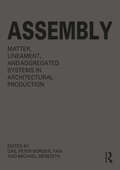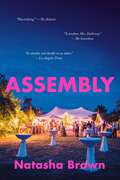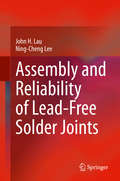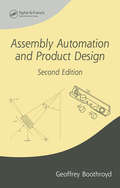- Table View
- List View
Assembling Health Care Organizations
by Kajsa Lindberg Alexander Styhre Lars WalterAssembling Health Care Organizations combines an institutional theory perspective with a materialist view of the technologies, devices, biological specimens, and other material resources mobilized and put to work in health care work.
Assembling Health Rights in Global Context: Genealogies and Anthropologies
by Alex Mold David ReubiWhat do we mean when we talk about rights in relation to health? Where does the language of health rights come from, and what are the implications of using such a discourse? During the last 20 years there have been an increasing number of initiatives and efforts – for instance in relation to HIV/AIDS – which draw on the language, institutions and procedures of human rights in the field of global health. This book explores the historical, cultural and social context of public health activists’ increasing use of rights discourse and examines the problems it can entail in practice. Structured around three interlinked themes, this book begins by looking at what health as a right means for our understandings of citizenship and political subjectivities. It then goes on to look at how and why some health problems came to be framed as human rights issues. The final part of the book investigates what happens when health rights are put into practice – how these are implemented, realised, cited, ignored and resisted. Assembling Health Rights in Global Context provides an in-depth discussion of the historical, anthropological, social and political context of rights in health and develops much needed critical perspectives on the human rights approach to global health. It will be of interest to scholars of public health and human rights within health care as well as sociology and anthropology.
Assembling Moral Mobilities: Cycling, Cities, and the Common Good
by Nicholas A. ScottIn the years since the new mobilities paradigm burst onto the social scientific scene, scholars from various disciplines have analyzed the social, cultural, and political underpinnings of transport, contesting its long-dominant understandings as defined by engineering and economics. Still, the vast majority of mobility studies, and even key works that mention the &“good life&” and its dependence on the car, fail to consider mobilities in connection with moral theories of the common good. In Assembling Moral Mobilities Nicholas A. Scott presents novel ways of understanding how cycling and driving animate urban space, place, and society and investigates how cycling can learn from the ways in which driving has become invested with moral value. By jointly analyzing how driving and cycling reassembled the &“good city&” between 1901 and 2017, with a focus on various cities in Canada, in Detroit, and in Oulu, Finland, Scott confronts the popular notion that cycling and driving are merely antagonistic systems and challenges social-scientific research that elides morality and the common good. Instead of pitting bikes against cars, Assembling Moral Mobilities looks at five moral values based on canonical political philosophies of the common good, and argues that both cycling and driving figure into larger, more important &“moral assemblages of mobility,&” finally concluding that the deeper meta-lesson that proponents of cycling ought to take from driving is to focus on ecological responsibility, equality, and home at the expense of neoliberal capitalism. Scott offers a fresh perspective of mobilities and the city through a multifaceted investigation of cycling informed by historical lessons of automobility.
Assembling Neoliberalism: Expertise, Practices, Subjects
by Vaughan Higgins Wendy LarnerThis book examines how neoliberalism is constituted from multiple, diverse elements; how these elements are brought together and made to cohere; and the challenges, contestations, and consequences of such. Informed by assemblage thinking, the collection builds on research that emphasizes the forms of experimentation, adaptation, and mutation through which neoliberalism is enacted and rendered workable across different spaces. Contributors provide original case studies on topics such as democratic administration, carbon markets, the sharing economy, behavioral economics, disease management, free trade, and youth volunteering. They interrogate the forms of expertise through which neoliberalism is rendered knowab≤ the diverse socio-technical practices that make neoliberalism governab≤ and the practices, effects, and tensions involved in the assembling of neoliberal subjects.
Assembling Nusantara: Mimicry, Friction, and Resonance in the New Capital Development (Advances in 21st Century Human Settlements)
by Lilis Mulyani Henny Warsilah Ivan Kurniawan NasutionToday, the new Indonesian capital city, Nusantara, planning is being anticipated as “representing national identity,” “a model city,” or “a gift to the world,” and many other extraordinary labels. This book examines the reality of an ongoing developmental transformation of the Nusantara beyond those labels. It approaches its assemblage of humans, their works (plans, documents, policies, and others), non-human objects (biodiversity, landscape, geography, physical infrastructure, buildings, and public spaces), processes, social relationships, social infrastructures, and others. It is organized into three themes—mimicry, friction, and resonance. The mimicry illustrates the similarities (and differences) between Nusantara and other capital cities in urban narratives, imageries, and forms. The friction studies how Nusantara moves actors who do not always agree, processes that do not always align or collaboration between diverse contradicting groups that intersect. The resonance observes how Nusantara resonates with, yet communicates its voice toward, the world. The three concepts (originated from geography, anthropology, and sociology) frame the analytics of the various contributions of local and foreign scientists from multiple disciplines. Overall, the book recommends “Otorita Ibu Kota Nusantara” (Nusantara capital city authority) on the current experimentation and implementation of the urban vision and provides a reference for social scientists to study Nusantara. And more broadly, the book offers the current socio-spatial practices of capital city-making in Asia that are valuable for the region.
Assembling Panoramic Photos: A Designer's Notebook
by William RodarmorIn this full-color Designer's Notebook, eight expert French photographers reveal their secrets in using Photoshop and a collection of dedicated applications to create extraordinary panoramic photos--including some amazing 360-degree images. For anyone involved with digital imagery or animation, this groundbreaking volume demonstrates a new way of thinking about what's possible and what's required to produce these images. Originally published in France, Assembling Panoramic Photos: A Designer's Notebook is available in English for the first time. Part art book, part how-to guide, this stunning work takes you right into the studio and sits you down next to renowned digital artists as they advance step-by-step toward their final images. The showcased pieces are inspiring and avant-garde, and the techniques are instructive for a wide range of amateur and professional photographers, graphic designers, and digital artists. The artists featured in this Designer's Notebook show how they use Photoshop, Stitcher, PanaVue ImageAssembler, and other specialized tools to create high-quality panoramas and wide-angle images from a series of photos. They also show how to create virtual reality scenes with Apple's QuickTime VR in conjunction with leading-edge technologies that support 360-degree one-shot photos, cubic images, and 3D views of objects. The results are interactive, often startling, and bear the hallmark of each artist's original vision and skill. Reflecting the very best of French photography, graphic design and digital artistry, Assembling Panoramic Photos: A Designer's Notebook offers advanced Photoshop instruction that goes beyond opening this menu, or clicking that palette. You receive expert aesthetic guidance, from start to finish, with notes and views that reveal every step of the process. This book is a goldmine for any digital artist who wants to learn new Photoshop techniques and exploit them for maximum effect. At home on either your coffee table or desktop, the book itself is dazzling in concept and design. There's nothing else quite like this Designer's Notebook available in the U.S.
Assembling Past Worlds: Materials, Bodies and Architecture in Neolithic Britain
by Oliver J.T. HarrisAssembling Past Worlds draws on new materialism and the philosophy of Gilles Deleuze to explore the potential for a posthumanist archaeology. Through specific empirical study, this book provides a detailed analysis of Neolithic Britain, a critical moment in the emergence of new ways of living, as well as new relationships between materials, people and new forms of architecture. It achieves two things. First, it identifies the major challenges that archaeology faces in the light of current theoretical shifts. New ideas place new demands on how we write and think about the past, sometimes in ways that can seem contradictory. This volume identifies seven major challenges that have emerged and sets out why they matter, why archaeology needs to engage with them and how they can be dealt with through an innovative theoretical approach. Second, it explores how this approach meets these challenges through an in-depth study of Neolithic Britain. It provides an insightful diagnosis of the issues posed by current archaeological thought and is the first volume to apply the philosophy of Gilles Deleuze to the extended analysis of a single period. Assembling Past Worlds shows how new approaches are transforming our understandings of past worlds and, in so doing, how we can meet the challenges facing archaeology today. It will be of interest to both students and researchers in archaeological theory and the Neolithic of Europe.
Assembling Petroleum Production and Climate Change in Ecuador and Norway (Routledge Explorations in Energy Studies)
by Elisabeth Marta TómmerbakkThis book addresses some of the controversies and uncertainties associated with reducing the extensive exploitation of fossil fuels due to their role in global warming. Elisabeth Marta Tómmerbakk explores why a transition towards a post-carbon society is so difficult to accomplish by examining how the relationship between petroleum production and climate change is politically framed and negotiated in contested cases. This question is approached through a process-oriented comparative case study of Lofoten, located in the Norwegian Sea above the Arctic Circle, and Yasuní-ITT (Ishpingo, Tambococha, and Tiputini) located in the Ecuadorian Amazon: regions that both belong to oil-exporting countries with highly oil-dependent economies. Tómmerbakk draws on rich empirical data that includes qualitative interviews with subjects in both countries and applies an Actor-Network Theory framework to show that oil and climate are intricately entangled in knowledge and policy practices. Overall, Assembling Petroleum Production and Climate Change in Ecuador and Norway provides an in-depth examination of how climate science and petroleum extraction are negotiated, adapted, assembled, and coordinated with other national policies and political aims. This book will be of great interest to students and scholars of petroleum production, climate change, environmental policy, and environmental sociology.
Assembling Policy: Transantiago, Human Devices, and the Dream of a World-Class Society (Infrastructures)
by Sebastian UretaAn examination of how human beings are brought into the planning of complex infrastructure projects, through analysis of a controversial public transportation project.Policymakers are regularly confronted by complaints that ordinary people are left out of the planning and managing of complex infrastructure projects. In this book, Sebastián Ureta argues that humans, both individually and collectively, are always at the heart of infrastructure policy; the issue is how they are brought into it. Ureta develops his argument through the case of Transantiago, a massive public transportation project in the city of Santiago, proposed in 2000, launched in 2007, and in 2012 called “the worst public policy ever implemented in our country” by a Chilean government spokesman. Ureta examines Transantiago as a policy assemblage formed by an array of heterogeneous elements—including, crucially, “human devices,” or artifacts and practices through which humans were brought into infrastructure planning and implementation. Ureta traces the design and operation of Transantiago through four configurations: crisis, infrastructuration, disruption, and normalization. In the crisis phase, humans were enacted both as consumers and as participants in the transformation of Santiago into a “world-class” city, but during infrastructuration the “active citizen” went missing. The launch of Transantiago caused huge disruptions, in part because users challenged their role as mere consumers and instead enacted unexpected human devices. Resisting calls for radical reform, policymakers insisted on normalizing Transantiago, transforming it into a permanent failing system. Drawing on Chile's experience, Ureta argues that if we understand policy as a series of heterogeneous assemblages, infrastructure policymaking would be more inclusive, reflexive, and responsible.
Assembling Religion: The Ford Motor Company and the Transformation of Religion in America
by Kati CurtsHow Henry Ford institutionalized a social gospelHenry Ford did not just mass produce cars. As a member of the Episcopal Church, reader of New Thought texts, believer in the “gospel of reincarnation,” mass marketer of antisemitic material, and employer who institutionalized a social gospel, Henry Ford’s contributions to American models of business were informed by and produced for an America he understood to be broadly Christian. Though Ford’s efforts at the head of the Ford Motor Company have commonly been understood as secular, Ford himself was explicit that his work in engineering and auto production was prophetic and meant to remake the world.This religious history of Henry Ford and the Ford Motor Company repositions them within critical studies of religion, examining how Ford transformed American religious practice in the twentieth century. Drawing directly on documents from Ford’s archive, it examines Ford’s mass production methods and bureaucratic reforms as examples of prosperity gospel traditions, illuminating the ways manufacturing and technology intersect with American religious practice. Bridging American religious and industrial history, Assembling Religion offers a new and surprising way to understand Ford’s impact on culture, commerce, and the technology of labor.
Assembling Smartphones: Takt Time Cycle Time?
by Ethan S. Bernstein Willy ShihThe case was prepared to be used as part of a process review in the first year Technology and Operations Management course at HBS. It offers students an opportunity to discuss the context of a manufacturing process choice, and then examine actual production numbers that resulted from a series of choices. While there isn't a traditional case issue, the discussion should focus on the gap between theoretical process designs and the reality of practical implementations, with the impact of operator variability in pace and the complex intertwining with work scope. The case only meant for one discussion pasture to review the Hayes-Wheelwright product-process matrix, and the impact of variability on line performance. While comparative numbers for the process choices are provided, the hope would be to develop students' intuition around why the numbers change so much.
Assembling the Centre: Australia and Beyond (Routledge Research in Architecture)
by Anoma Pieris Janet McGawMetropolitan Indigenous Cultural Centres have become a focal point for making Indigenous histories and contemporary cultures public in settler-colonial societies over the past three decades. While there are extraordinary success stories, there are equally stories that cause concern: award-winning architecturally designed Indigenous cultural centres that have been abandoned; centres that serve the interests of tourists but fail to nourish the cultural interests of Indigenous stakeholders; and places for vibrant community gathering that fail to garner the economic and politic support to remain viable. Indigenous cultural centres are rarely static. They are places of ‘emergence’, assembled and re-assembled along a range of vectors that usually lie beyond the gaze of architecture. How might the traditional concerns of architecture – site, space, form, function, materialities, tectonics – be reconfigured to express the complex and varied social identities of contemporary Indigenous peoples in colonised nations? This book, documents a range of Indigenous Cultural Centres across the globe and the processes that led to their development. It explores the possibilities for the social and political project of the Cultural Centre that architecture both inhibits and affords. Whose idea of architecture counts when designing Indigenous Cultural Centres? How does architectural history and contemporary practice territorialise spaces of Indigenous occupation? What is architecture for Indigenous cultures and how is it recognised? This ambitious and provocative study pursues a new architecture for colonised Indigenous cultures that takes the politics of recognition to its heart. It advocates an ethics of mutual engagement as a crucial condition for architectural projects that design across cultural difference. The book’s structure, method, and arguments are dialogically assembled around narratives told by Indigenous people of their pursuit of public recognition, spatial justice, and architectural presence in settler dominated societies. Possibilities for decolonising architecture emerge through these accounts.
Assembling the Dinosaur: Fossil Hunters, Tycoons, and the Making of a Spectacle
by Lukas RieppelLukas Rieppel shows how dinosaurs gripped the popular imagination and became emblems of America’s industrial power and economic prosperity during the Gilded Age. Spectacular fossils were displayed in museums financed by North America’s wealthiest tycoons, to cement their reputation as both benefactors of science and fierce capitalists.
Assembling the Dinosaur: Fossil Hunters, Tycoons, and the Making of a Spectacle
by Lukas RieppelA lively account of the dinosaur’s role in Gilded Age America, examining the connection between business, paleontology, and museums.Although dinosaur fossils were first found in England, a series of dramatic discoveries during the late 1800s turned North America into a world center for vertebrate paleontology. At the same time, the United States emerged as the world’s largest industrial economy, and creatures like Tyrannosaurus, Brontosaurus, and Triceratops became emblems of American capitalism. Large, fierce, and spectacular, American dinosaurs dominated the popular imagination, making front-page headlines and appearing in feature films.Assembling the Dinosaur follows dinosaur fossils from the field to the museum and into the commercial culture of North America’s Gilded Age. Business tycoons like Andrew Carnegie and J. P. Morgan made common cause with vertebrate paleontologists to capitalize on the widespread appeal of dinosaurs, using them to project American exceptionalism back into prehistory. Learning from the show-stopping techniques of P. T. Barnum, museums exhibited dinosaurs to attract, entertain, and educate the public. By assembling the skeletons of dinosaurs into eye-catching displays, wealthy industrialists sought to cement their own reputations as generous benefactors of science, showing that modern capitalism could produce public goods in addition to profits. Behind the scenes, museums adopted corporate management practices to control the movement of dinosaur bones, restricting their circulation to influence their meaning and value in popular culture.Tracing the entwined relationship of dinosaurs, capitalism, and culture during the Gilded Age, Lukas Rieppel reveals the outsized role these giant reptiles played during one of the most consequential periods in American history.Praise for Assembling the Dinosaur“A penetrating study of legitimacy and capitalism in the realm of fossils.” —Verlyn Klinkenborg, The New York Review of Books“A solid entry into the growing body of literature on Gilded Age American paleontology, but it is particularly valuable for its contribution to enhancing our understanding of how science and its representation during that period were influenced by, and in turn affected, society as a whole. By incorporating cultural, economic, and scientific developments, Rieppel shines new light on the history of both American paleontology and museum exhibition practice.” —Ilja Nieuwland, Science
Assembling the Local: Political Economy and Agrarian Governance in British India (Intellectual History of the Modern Age)
by Upal ChakrabartiIn 1817, in a region of the eastern coast of British India then known as Cuttack, a group of Paiks, the area's landed militia, began agitating against the East India Company's government, burning down government buildings and looting the treasury. While the attacks were initially understood as an attempt to return the territory's native ruler to power, investigations following the rebellion's suppression traced the cause back to the introduction of a model of revenue governance unsuited to local conditions. Elsewhere in British India, throughout the first half of the nineteenth century, interregional debates over revenue settlement models and property disputes in villages revealed an array of practices of governance that negotiated with the problem of their applicability to local conditions. And at the same time in Britain, the dominant Ricardian conception of political economy was being challenged by thinkers like Richard Jones and William Whewell, who sought to make political economy an inductive science, capable of analyzing the real world.Through analyses of these three interrelated moments in British imperial history, Upal Chakrabarti's Assembling the Local engages with articulations of the "local" on multiple theoretical and empirical fronts, weaving them into a complex reflection on the problem of difference and a critical commentary on connections between political economy, agrarian property, and governance. Chakrabarti argues that the "local" should be reconceptualized as an abstract machine, central to the construction of the universal, namely, the establishment of political economy as a form of governance in nineteenth-century British India.
Assembling the Startup Team
by Noam WassermanNothing can bedevil a high-potential startup more than its "people problems." These problems typically result from choices that founders make as they add team members to their startup team. Three characteristics of startup teams must be aligned for these teams to function well: relationships, roles, and rewards (the Three Rs). Early decisions that founders make about the Three Rs can significantly affect their startup's direction and success. This note explores some of these choices and their long-term implications.
Assembling the Tropics: Science and Medicine in Portugal's Empire, 1450–1700 (Studies in Comparative World History)
by Hugh CagleFrom popular fiction to modern biomedicine, the tropics are defined by two essential features: prodigious nature and debilitating illness. That was not always so. In this engaging and imaginative study, Hugh Cagle shows how such a vision was created. Along the way, he challenges conventional accounts of the Scientific Revolution. The history of 'the tropics' is the story of science in Europe's first global empire. Beginning in the late fifteenth century, Portugal established colonies from sub-Saharan Africa to Southeast Asia and South America, enabling the earliest comparisons of nature and disease across the tropical world. Assembling the Tropics shows how the proliferation of colonial approaches to medicine and natural history led to the assemblage of 'the tropics' as a single, coherent, and internally consistent global region. This is a story about how places acquire medical meaning, about how nature and disease become objects of scientific inquiry, and about what is at stake when that happens.
Assembling Therapeutics: Cultures, Politics and Materiality (Therapeutic Cultures)
by Suvi Salmenniemi Johanna Nurmi Inna Perheentupa Harley BergrothThis volume examines the ways in which people engage with therapeutic practices, such as life coaching, mindfulness, complementary and alternative medicine, sex and relationship counselling, spiritual healing and self-tracking. It investigates how human and non-human actors, systems of thought and practice are assembled and interwoven in therapeutic engagements, and traces the situated, material and political dimensions of these engagements. By focusing on lived experiences through ethnographically informed case studies, the book elucidates the diverse forms, meanings and embodied effects of therapeutic engagements in different settings, as well as their potential for both oppressive and subversive social change. In this way, Assembling Therapeutics contributes to our understanding of multiple modes of healing, self-knowledge and power in contemporary societies.
Assembling Tomorrow: A Guide to Designing a Thriving Future from the Stanford d.school (Stanford d.school Library)
by Scott Doorley Stanford d.school Carissa CarterA powerful guide to why even the most well-intentioned innovations go haywire, and the surprising ways we can change course to create a more positive future, by two celebrated experts working at the intersection of design, technology, and learning at Stanford University&’s acclaimed d.school.&“This brilliant book offers a new approach to all creative work that will expand your understanding of what it means to make and open up possibilities you didn&’t know existed—it did for me.&”—Adam Johnson, Pulitzer Prize-winning author of The Orphan Master&’s SonIn Assembling Tomorrow, authors Scott Doorley and Carissa Carter explore the intangible forces that prevent us from anticipating just how fantastically technology can get out of control, and what might be in store for us if we don&’t start using new tools and tactics. Despite our best intentions, our most transformative innovations tend to have consequences we can&’t always predict. From the effects of social media to the uncertainty of AI and the consequences of climate change, the outcomes of our creations ripple across our lives. Time and again, our seemingly ceaseless capacity to create rubs up against our limited capacity to understand our impact. Assembling Tomorrow explores how to use readily accessible tools to both mend the mistakes of our past and shape our future for the better. We live in an era of &“runaway design,&” where innovations tangle with our lives in unpredictable ways. This book explores the off-kilter feelings of today and follows up with actionables to alter your perspective and help you find opportunities in these turbulent times. Mixed throughout are histories of the future, short pieces of speculative fiction that imagine the future as if it has already happened and consider the past with a critical yet hopeful eye so that all of us—as designers of our own futures—can create a better world for generations to come.
Assembling Your Opportunity Portfolio: Allocating Resources Employing an Entrepreneurial Mindset
by Ian Macmillan Rita Gunther McgrathIn uncertain times, it's essential that you practice the nimble thought process and discipline that are second nature to successful entrepreneurs. This entrepreneurial mindset will help you build an arsenal of new opportunities. One of the key challenges is figuring out how you are going to appropriately allocate resources to those opportunities that you elect to pursue. As illustrated in this chapter, using real options reasoning to guide your investment of people and resources in new opportunities can allow you to pursue attractive opportunities without burning your organization out and without wasting scarce resources. This chapter is excerpted from "The Entrepreneurial Mindset: Strategies for Continuously Creating Opportunity in an Age of Uncertainty."
Assembly: Matter, Lineament, and Aggregated Systems in Architectural Production
by Gail Peter Borden Michael MeredithPart-to-part relationships and the approach to governing their sensibilities is at the root of all architecture. The need for engaging in a dialogue around these systems is essential to contemporary architectural discourse and practice. Assembly builds on and extends the investigations of materials and representation techniques in the editors’ previous books, Matter and Lineament. This book uses a collection of detailed case studies, explained by first-person authors, about experimental and innovative takes on assembling architecture. Bridging theory and practice, 17 projects and their principled approaches each demonstrate an important vein of inquiry within the topic. Essays probe issues such as latent and overt geometry, fabrication and technology, part-to-part elements, joinery and representation, material vernacular geometries, labor and place-based contextual assemblies, detailing, and pedagogical examinations. This text articulates the traditions and trends of material as the defining premise in the contemporary making of architecture. Its outcomes are applicable to beginning students of architecture and advanced practitioners alike.
Assembly
by Natasha BrownOne woman. One day. One decision. A blistering, fearless, and unforgettable literary debut from "a stunning new writer." (Bernardine Evaristo)Come of age in the credit crunch. Be civil in a hostile environment. Go to college, get an education, start a career. Do all the right things. Buy an apartment. Buy art. Buy a sort of happiness. But above all, keep your head down. Keep quiet. And keep going.The narrator of Assembly is a black British woman. She is preparing to attend a lavish garden party at her boyfriend&’s family estate, set deep in the English countryside. At the same time, she is considering the carefully assembled pieces of herself. As the minutes tick down and the future beckons, she can&’t escape the question: is it time to take it all apart?Assembly is a story about the stories we live within – those of race and class, safety and freedom, winners and losers.And it is about one woman daring to take control of her own story, even at the cost of her life. With a steely, unfaltering gaze, Natasha Brown dismantles the mythology of whiteness, lining up the debris in a neat row and walking away."A modern Mrs. Dalloway."—The Guardian"Mind-bending and utterly original."—Brandon Taylor&“Slim in the hand, but its impact is massive.&”—Ali Smith
Assembly and Reliability of Lead-Free Solder Joints
by John H. Lau Ning-Cheng LeeThis book focuses on the assembly and reliability of lead-free solder joints. Both the principles and engineering practice are addressed, with more weight placed on the latter. This is achieved by providing in-depth studies on a number of major topics such as solder joints in conventional and advanced packaging components, commonly used lead-free materials, soldering processes, advanced specialty flux designs, characterization of lead-free solder joints, reliability testing and data analyses, design for reliability, and failure analyses for lead-free solder joints. Uniquely, the content not only addresses electronic manufacturing services (EMS) on the second-level interconnects, but also packaging assembly on the first-level interconnects and the semiconductor back-end on the 3D IC integration interconnects. Thus, the book offers an indispensable resource for the complete food chain of electronics products.
Assembly Automation and Product Design (ISSN)
by Geoffrey BoothroydThe design for assembly (DFA) method has become a widely used way for companies to introduce competitive designs at reduced costs. This text places the consideration and application of automatic assembly in the context of DFA, addressing product design for both automated and manual assembly processes. The author enumerates the components, processes, performance, and comparative economics of several types of automatic assembly systems. To this end, the book includes specific information on equipment such as transfer devices, parts feeders, feed tracks, placing mechanisms, and robots. This is an ideal reference and guide for manufacturing, product design, mechanical, and industrial engineers.
Assembly by Design: The United Nations and Its Global Interior (Buell Center Books in the History and Theory of American Architecture)
by Olga TouloumiHow the United Nations headquarters became the architectural instrument and broadcast medium of global diplomacy For almost seven years after World War II, a small group of architects took on an exciting task: to imagine the spaces of global governance for a new political organization called the United Nations (UN). To create the iconic headquarters of the UN in New York City, these architects experimented with room layouts, media technologies, and design in tribunal courtrooms, assembly halls, and council chambers. The result was the creation of a new type of public space, the global interior. Assembly by Design shows how this space leveraged media to help the UN communicate with the world. With its media infrastructure, symbols, acoustic design, and architecture, the global interior defined political assembly both inside and outside the UN headquarters, serving as the architectural medium to organize multilateral encounters of international publics around the globe. Demonstrating how aesthetics have long held sway over political work, Olga Touloumi posits that the building framed diplomacy on the ground amid a changing political landscape that brought the United States to the forefront of international politics, destabilizing old and establishing new geopolitical alliances. Uncovering previously closed institutional and family archives, Assembly by Design offers new information about the political and aesthetic decisions that turned the UN headquarters into a communications organism. It looks back at a moment of hope, when politicians, architects, and diplomats—believing that assembly was a matter of design—worked together to deliver platforms for global democracy and governance.
